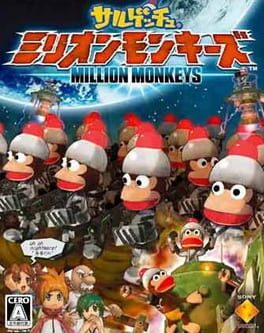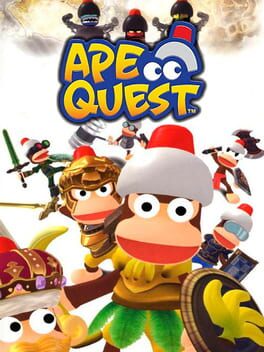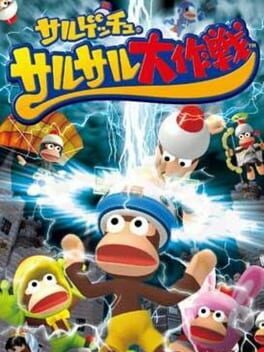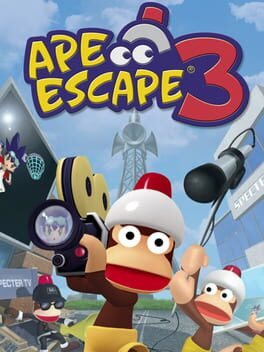Ape Escape: Million Monkeys
released on Jul 13, 2006
Ape Escape: Million Monkeys pits players against mech-equipped monkeys in real Japanese locations.
Also in series
Reviews View More
This is an Ape Escape game released in 2006 only in Japan, and it's one that I've been after for years. This year wasn't the first time I'd become obsessed with Ape Escape to the point where I tried hunting down as much about it as I could, and the numerous Japan-only PS2 games have always intrigued me. Last month I was FINALLY able to find a copy of Million Monkeys at the resale mall in town for the whopping price of 500 yen, and I snapped it up on the spot. The game doesn't keep playtime, so I reckon I played it for about 25 hours to beat both campaigns on normal mode as well as beat the colosseum mode.
Million Monkeys is what you get when you cross Ape Escape, Command & Conquer: Red Alert, and EDF. The game opens on Japan just as a swarm of interstellar battleships start attacking the planet. Kakeru (aka "Spike" in English, the protagonist of the first Ape Escape game) and his friends are visiting Tokyo to witness the unveiling of a new virtual world system when it occurs, and they see giant gorilla mechs and drop-pods full of machinegun-toting monkeys fall from the battleships overhead. News reports show a helicopter shot of Specter surrounded by some very strange other monkeys on a platform of the ship over Tokyo, revealing to everyone just who's behind this. It just so happens that "everyone" also includes Specter himself! Lounging on an island retreat, some of the monkeys he's brought along with him drag him a TV screen to show him the news bulletin, and he storms off to find out just what's up with this fake Specter who's stolen both his authority and his entire army. That's right. Ape Escape pulls a Sonic Adventure 2 and lets you play as both the good guys AND the (kinda) bad guys XD.
The actual story in the game past the intro is pretty light, but the stages are often prefaced with some sort of cutscene (especially in the second half) is all intermixed with a series of live action cutscenes in between some stages that show an English-language broadcast about the state of the war against the monkeys. It's genuinely like a news broadcast as well, with the newscaster speaking English while a Japanese voice dubs over her (but you can still understand her just fine). It occasionally cuts away to on-site reporting of the war in places from Russia to L.A. to Hamburg to right there in Tokyo, so those parts don't all have English, but just how odd and wacky these cutscenes are is surprisingly import-friendly to English speakers. The live-action stuff is easily one of my favorite things in the game, and as soon as I saw the front line report where the reporter has a banana bomb go off in her hand and cover her and the soldier next to her in bananas and banana peels, I knew this game was gold XD
The gameplay is much more like EDF meets Ape Escape. You don't have any of the "catch X-many monkeys!" levels like the main-line AE games do, and instead you have 31 missions with specific capture targets. Though there ARE technically two campaigns to go through, this is largely a matter of what characters you can use in each. For Kakeru's Episode (as the game calls it), you can pick between the four good guys (Kakeru, Natsumi, the Professor, and even Charu, the green haired girl who gave you mission objectives in AE1). For Specter's Episode, you can pick between Specter and a monkey team. The game does have more characters than that, and the characters even have persistant stats outside of the story mode, but that's really it for the story stuff. There are a handful of CGI cutscenes that are different between the two campaigns, but only one mission out of the 31 is actually different between them.
That said, the way each character plays and the weapons they get access to really does make each playthrough feel quite different. Everyone starts with the same-ish 5 weapons: a net, a melee item, dash boots, remote bombs, and a laser gun. If you're using one of your pre-built characters instead of one of the game-assigned ones, you will get parts at the end of each stage you beat. You can then combine these parts into new weapons, super moves, and cosmetic costumes and each character gets certain weapons in different orders or even weapons that only they can get (or weapons they never CAN get). Even their base equipment operates differently, with Specter's melee weapon being tonfa that hit way faster than Kakeru's bat, and Kakeru's laser gun having a faster rate of fire but less damage than Specter's. I was expecting the second playthrough I did to be a real slog, but it ended up being a really fun challenge to see how I could fare with these new (quite frankly often worse XP) weapons that Kakeru had.
The stages are broken up into a concrete mission objective, and you usually need to fight your way to get there. Sometimes it's as simple as "beat a boss", or even some special puzzle stages in the middle of the game or an escort mission here and there, but mostly it's taking down a target. Sometimes that target is a series of monkeys (usually one group at the halfway point, and then another group at the end), and sometimes it's other enemies or even static objectives. They generally revolve around the same action gameplay of beating up the monkeys to break their armor and then catch them, but these monkeys and their non-monkey enemy allies are TOUGH. This is not a very easy game, even on normal mode. One of the biggest reasons my Specter playthrough was so much easier than my Kakeru one is that he gets the (very good) shotgun much earlier than Kakeru does, and he also has way better special moves. Getting used to how best you should jump, dash, conserve ammo, and try to get in melee attacks when you can is integral to surviving the later half of the game.
The game also curiously doesn't record EVERY monkey you catch, with only a couple dozen specific ones being recorded. Each level has a score counter based on your monkey-catching combos (how many at once in a short period of time), mission completion time, bonus coins picked up in each stage, and health at the end of a mission. I never really felt compelled to go for high scores and you don't get anything for doing them, but it's neat that it's there. There's even a curious crossover with Sony's white cat Taro mascot, and he and his friends are hidden around many stages and you can pick them up on your radar. They're REALLY hard to find, but they're also recorded in the same place that the special monkeys you catch are (even though you only scan them, and not catch them).
The problems the game really has are as equally ignorable as they are omnipresent. The comparison to a game like EDF (or even a Musou game) is very apt, in that if you don't like a silly presentation with tons of enemies to kill, you very well might find even the campy cutscenes not enough of a carrot to warrant dealing with the stick of the only mildly complex combat. The camera can be a bit finicky at times (even though buttons can now activate your weapons, you can still use the right stick to use them, so the camera is entirely operated via the shoulder buttons), but it isn't a huge problem. Aside from that, the game has some pretty significant difficulty curve issues as well as bad character balancing. Some characters like Specter or Pipotron G are WAY more powerful than others due to way more default special moves and better/earlier selections of items. This isn't necessarily a problem, especially for a game where multiplayer isn't the focus, but it's certainly a kind of issue worth mentioning.
There isn't any level grinding in the game, and you really don't ever get much more powerful than you are. There are some side-grade chips you can make for items, but they rarely make you outright more powerful in a really significant way other than making your weapon recharge a bit faster/have more max ammo. This can make the difficulty curve issues way more of a bastard, as the hardest bosses in the game are at missions 15 and 16 (especially the Specter fight on mission 15), and the final boss is a pushover compared to them. The monkeys you have to fight get way harder as you go on, but even at the midpoint, feeling frustrated with how much better the game expects you to be can be an issue. This is also especially true if you're trying to get all the monkeys and not just rush through a stage, as these stages have no checkpoints and if you get a really unlucky combo you can lose a LOT of health really fast. It never gets nearly as bad as say, Drakengard 2, as you can rush through these stages if you were really so inclined, but it can still be a real pain in the butt to lose like 15-20 minutes of progress because the last gauntlet utterly destroyed you.
The game also has a weird system of unlocking characters, as it was done entirely through entering codes you got on their website (back during the time of launch). Despite being a neat marketing gimmick back then, now it just makes it kinda odd that you get nothing at all for completing both campaigns and the arena battle mode, which is just several rounds of you fighting 3 NPCs all with similar powers. It's fun, but ultimately pretty ignorable. The only thing really cool worth mentioning about the colosseum mode is that it reveals the game this game is actually a successor to rather than Ape Escape 3. It's a successor to Ape Escape: Pumped and Primed.
The game's presentation is a mixed bag. It has the aforementioned live action cutscenes, which are incredible and I love them, but the game also entirely lacks subtitles, as I guess Sony just hated deaf people during the first decade of the 2000's with how many of their first party-published games don't have them or have damn-near useless ones. The art style is a bit sharper and lower poly than the other AE PS2 games, and while it does look nice and clean, it was no doubt done to make the game run better (as even AE3 runs terrribly). While this game does get framerate dips, it's never anything horrible. The music is also pretty forgettable, and the game has a weirdly small selection of tracks. SO many missions have the exact same music it makes it feel like the game has like, a dozen total songs in it XD
Verdict: Highly Recommended. Despite all my criticisms, I think this game's pluses heavily outweigh its minuses as far as my taste is concerned. The weird Red Alert-style cutscenes on top of the already really weird story and really solid gameplay make for a whole more than the sum of its parts. It isn't the most import-friendly game in the world (especially in regards to weapon and upgrade management), but it's also not the most impossible import in the world to fumble your way through if you don't know any Japanese at all. Either way, this is probably one of the best Japan-exclusive games I've ever played, and I'm so so happy that I was finally able to track this one down and play through it~.
Million Monkeys is what you get when you cross Ape Escape, Command & Conquer: Red Alert, and EDF. The game opens on Japan just as a swarm of interstellar battleships start attacking the planet. Kakeru (aka "Spike" in English, the protagonist of the first Ape Escape game) and his friends are visiting Tokyo to witness the unveiling of a new virtual world system when it occurs, and they see giant gorilla mechs and drop-pods full of machinegun-toting monkeys fall from the battleships overhead. News reports show a helicopter shot of Specter surrounded by some very strange other monkeys on a platform of the ship over Tokyo, revealing to everyone just who's behind this. It just so happens that "everyone" also includes Specter himself! Lounging on an island retreat, some of the monkeys he's brought along with him drag him a TV screen to show him the news bulletin, and he storms off to find out just what's up with this fake Specter who's stolen both his authority and his entire army. That's right. Ape Escape pulls a Sonic Adventure 2 and lets you play as both the good guys AND the (kinda) bad guys XD.
The actual story in the game past the intro is pretty light, but the stages are often prefaced with some sort of cutscene (especially in the second half) is all intermixed with a series of live action cutscenes in between some stages that show an English-language broadcast about the state of the war against the monkeys. It's genuinely like a news broadcast as well, with the newscaster speaking English while a Japanese voice dubs over her (but you can still understand her just fine). It occasionally cuts away to on-site reporting of the war in places from Russia to L.A. to Hamburg to right there in Tokyo, so those parts don't all have English, but just how odd and wacky these cutscenes are is surprisingly import-friendly to English speakers. The live-action stuff is easily one of my favorite things in the game, and as soon as I saw the front line report where the reporter has a banana bomb go off in her hand and cover her and the soldier next to her in bananas and banana peels, I knew this game was gold XD
The gameplay is much more like EDF meets Ape Escape. You don't have any of the "catch X-many monkeys!" levels like the main-line AE games do, and instead you have 31 missions with specific capture targets. Though there ARE technically two campaigns to go through, this is largely a matter of what characters you can use in each. For Kakeru's Episode (as the game calls it), you can pick between the four good guys (Kakeru, Natsumi, the Professor, and even Charu, the green haired girl who gave you mission objectives in AE1). For Specter's Episode, you can pick between Specter and a monkey team. The game does have more characters than that, and the characters even have persistant stats outside of the story mode, but that's really it for the story stuff. There are a handful of CGI cutscenes that are different between the two campaigns, but only one mission out of the 31 is actually different between them.
That said, the way each character plays and the weapons they get access to really does make each playthrough feel quite different. Everyone starts with the same-ish 5 weapons: a net, a melee item, dash boots, remote bombs, and a laser gun. If you're using one of your pre-built characters instead of one of the game-assigned ones, you will get parts at the end of each stage you beat. You can then combine these parts into new weapons, super moves, and cosmetic costumes and each character gets certain weapons in different orders or even weapons that only they can get (or weapons they never CAN get). Even their base equipment operates differently, with Specter's melee weapon being tonfa that hit way faster than Kakeru's bat, and Kakeru's laser gun having a faster rate of fire but less damage than Specter's. I was expecting the second playthrough I did to be a real slog, but it ended up being a really fun challenge to see how I could fare with these new (quite frankly often worse XP) weapons that Kakeru had.
The stages are broken up into a concrete mission objective, and you usually need to fight your way to get there. Sometimes it's as simple as "beat a boss", or even some special puzzle stages in the middle of the game or an escort mission here and there, but mostly it's taking down a target. Sometimes that target is a series of monkeys (usually one group at the halfway point, and then another group at the end), and sometimes it's other enemies or even static objectives. They generally revolve around the same action gameplay of beating up the monkeys to break their armor and then catch them, but these monkeys and their non-monkey enemy allies are TOUGH. This is not a very easy game, even on normal mode. One of the biggest reasons my Specter playthrough was so much easier than my Kakeru one is that he gets the (very good) shotgun much earlier than Kakeru does, and he also has way better special moves. Getting used to how best you should jump, dash, conserve ammo, and try to get in melee attacks when you can is integral to surviving the later half of the game.
The game also curiously doesn't record EVERY monkey you catch, with only a couple dozen specific ones being recorded. Each level has a score counter based on your monkey-catching combos (how many at once in a short period of time), mission completion time, bonus coins picked up in each stage, and health at the end of a mission. I never really felt compelled to go for high scores and you don't get anything for doing them, but it's neat that it's there. There's even a curious crossover with Sony's white cat Taro mascot, and he and his friends are hidden around many stages and you can pick them up on your radar. They're REALLY hard to find, but they're also recorded in the same place that the special monkeys you catch are (even though you only scan them, and not catch them).
The problems the game really has are as equally ignorable as they are omnipresent. The comparison to a game like EDF (or even a Musou game) is very apt, in that if you don't like a silly presentation with tons of enemies to kill, you very well might find even the campy cutscenes not enough of a carrot to warrant dealing with the stick of the only mildly complex combat. The camera can be a bit finicky at times (even though buttons can now activate your weapons, you can still use the right stick to use them, so the camera is entirely operated via the shoulder buttons), but it isn't a huge problem. Aside from that, the game has some pretty significant difficulty curve issues as well as bad character balancing. Some characters like Specter or Pipotron G are WAY more powerful than others due to way more default special moves and better/earlier selections of items. This isn't necessarily a problem, especially for a game where multiplayer isn't the focus, but it's certainly a kind of issue worth mentioning.
There isn't any level grinding in the game, and you really don't ever get much more powerful than you are. There are some side-grade chips you can make for items, but they rarely make you outright more powerful in a really significant way other than making your weapon recharge a bit faster/have more max ammo. This can make the difficulty curve issues way more of a bastard, as the hardest bosses in the game are at missions 15 and 16 (especially the Specter fight on mission 15), and the final boss is a pushover compared to them. The monkeys you have to fight get way harder as you go on, but even at the midpoint, feeling frustrated with how much better the game expects you to be can be an issue. This is also especially true if you're trying to get all the monkeys and not just rush through a stage, as these stages have no checkpoints and if you get a really unlucky combo you can lose a LOT of health really fast. It never gets nearly as bad as say, Drakengard 2, as you can rush through these stages if you were really so inclined, but it can still be a real pain in the butt to lose like 15-20 minutes of progress because the last gauntlet utterly destroyed you.
The game also has a weird system of unlocking characters, as it was done entirely through entering codes you got on their website (back during the time of launch). Despite being a neat marketing gimmick back then, now it just makes it kinda odd that you get nothing at all for completing both campaigns and the arena battle mode, which is just several rounds of you fighting 3 NPCs all with similar powers. It's fun, but ultimately pretty ignorable. The only thing really cool worth mentioning about the colosseum mode is that it reveals the game this game is actually a successor to rather than Ape Escape 3. It's a successor to Ape Escape: Pumped and Primed.
The game's presentation is a mixed bag. It has the aforementioned live action cutscenes, which are incredible and I love them, but the game also entirely lacks subtitles, as I guess Sony just hated deaf people during the first decade of the 2000's with how many of their first party-published games don't have them or have damn-near useless ones. The art style is a bit sharper and lower poly than the other AE PS2 games, and while it does look nice and clean, it was no doubt done to make the game run better (as even AE3 runs terrribly). While this game does get framerate dips, it's never anything horrible. The music is also pretty forgettable, and the game has a weirdly small selection of tracks. SO many missions have the exact same music it makes it feel like the game has like, a dozen total songs in it XD
Verdict: Highly Recommended. Despite all my criticisms, I think this game's pluses heavily outweigh its minuses as far as my taste is concerned. The weird Red Alert-style cutscenes on top of the already really weird story and really solid gameplay make for a whole more than the sum of its parts. It isn't the most import-friendly game in the world (especially in regards to weapon and upgrade management), but it's also not the most impossible import in the world to fumble your way through if you don't know any Japanese at all. Either way, this is probably one of the best Japan-exclusive games I've ever played, and I'm so so happy that I was finally able to track this one down and play through it~.
reeaallly repetitive. it has a different approach to the ape escape's gameplay - like a review said, it's pretty much similar to musou genre
also it has a much higher difficult. but to be fair, there are so many items to unlock i didn't have idea that were possible, as this game was never officially located
also it has a much higher difficult. but to be fair, there are so many items to unlock i didn't have idea that were possible, as this game was never officially located





